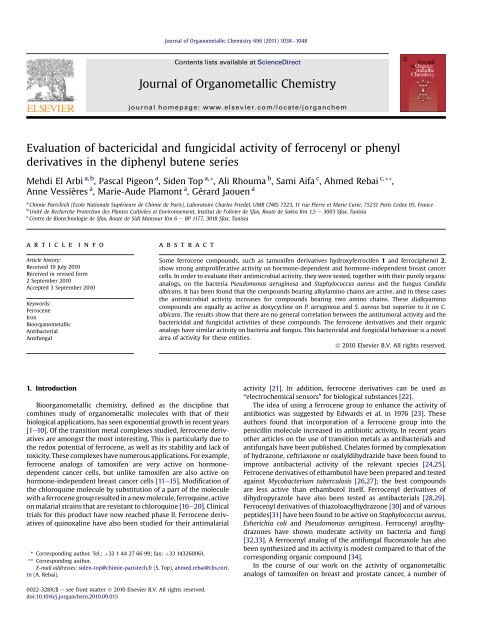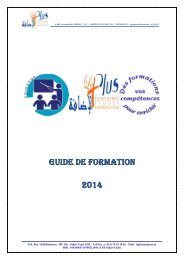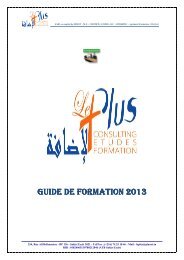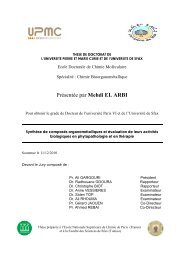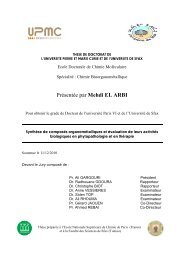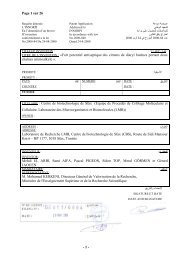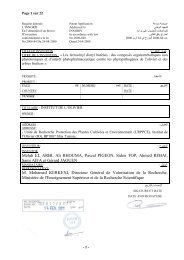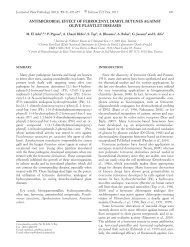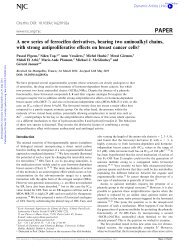Evaluation of bactericidal and fungicidal activity of ferrocenyl or phenyl derivatives...
Ferrocene compounds
Ferrocene compounds
Create successful ePaper yourself
Turn your PDF publications into a flip-book with our unique Google optimized e-Paper software.
<strong>Evaluation</strong> <strong>of</strong> <strong>bactericidal</strong> <strong>and</strong> <strong>fungicidal</strong> <strong>activity</strong> <strong>of</strong> <strong>ferrocenyl</strong> <strong>or</strong> <strong>phenyl</strong><br />
<strong>derivatives</strong> in the di<strong>phenyl</strong> butene series<br />
Mehdi El Arbi a,b , Pascal Pigeon a , Siden Top a, *, Ali Rhouma b , Sami Aifa c , Ahmed Rebai c, **,<br />
Anne Vessières a , Marie-Aude Plamont a , Gérard Jaouen a<br />
a<br />
Chimie ParisTech (Ecole Nationale Supérieure de Chimie de Paris), Lab<strong>or</strong>atoire Charles Friedel, UMR CNRS 7223, 11 rue Pierre et Marie Curie, 75231 Paris Cedex 05, France<br />
b<br />
Unité de Recherche Protection des Plantes Cultivées et Environnement, Institut de l’olivier de Sfax, Route de Sokra Km 1,5 e 3003 Sfax, Tunisia<br />
c<br />
Centre de Biotechnologie de Sfax, Route de Sidi Mansour Km 6 e BP 1177, 3018 Sfax, Tunisia<br />
article info<br />
Article hist<strong>or</strong>y:<br />
Received 19 July 2010<br />
Received in revised f<strong>or</strong>m<br />
2 September 2010<br />
Accepted 3 September 2010<br />
Keyw<strong>or</strong>ds:<br />
Ferrocene<br />
Iron<br />
Bio<strong>or</strong>ganometallic<br />
Antibacterial<br />
Antifungal<br />
1. Introduction<br />
abstract<br />
Bio<strong>or</strong>ganometallic chemistry, defined as the discipline that<br />
combines study <strong>of</strong> <strong>or</strong>ganometallic molecules with that <strong>of</strong> their<br />
biological applications, has seen exponential growth in recent years<br />
[1e10]. Of the transition metal complexes studied, ferrocene <strong>derivatives</strong><br />
are amongst the most interesting. This is particularly due to<br />
the redox potential <strong>of</strong> ferrocene, as well as its stability <strong>and</strong> lack <strong>of</strong><br />
toxicity. These complexes have numerous applications. F<strong>or</strong> example,<br />
ferrocene analogs <strong>of</strong> tamoxifen are very active on h<strong>or</strong>monedependent<br />
cancer cells, but unlike tamoxifen are also active on<br />
h<strong>or</strong>mone-independent breast cancer cells [11e15]. Modification <strong>of</strong><br />
the chl<strong>or</strong>oquine molecule by substitution <strong>of</strong> a part <strong>of</strong> the molecule<br />
with a ferrocene group resulted in a new molecule, ferroquine, active<br />
on malarial strains that are resistant to chl<strong>or</strong>oquine [16e20]. Clinical<br />
trials f<strong>or</strong> this product have now reached phase II. Ferrocene <strong>derivatives</strong><br />
<strong>of</strong> quinoxaline have also been studied f<strong>or</strong> their antimalarial<br />
* C<strong>or</strong>responding auth<strong>or</strong>. Tel.: þ33 1 44 27 66 99; fax: þ33 143260061.<br />
** C<strong>or</strong>responding auth<strong>or</strong>.<br />
E-mail addresses: siden-top@chimie-paristech.fr (S. Top), ahmed.rebai@cbs.rnrt.<br />
tn (A. Rebai).<br />
0022-328X/$ e see front matter Ó 2010 Elsevier B.V. All rights reserved.<br />
doi:10.1016/j.j<strong>or</strong>ganchem.2010.09.015<br />
Journal <strong>of</strong> Organometallic Chemistry 696 (2011) 1038e1048<br />
Contents lists available at ScienceDirect<br />
Journal <strong>of</strong> Organometallic Chemistry<br />
journal homepage: www.elsevier.com/locate/j<strong>or</strong>ganchem<br />
Some ferrocene compounds, such as tamoxifen <strong>derivatives</strong> hydroxyferrocifen 1 <strong>and</strong> ferrociphenol 2,<br />
show strong antiproliferative <strong>activity</strong> on h<strong>or</strong>mone-dependent <strong>and</strong> h<strong>or</strong>mone-independent breast cancer<br />
cells. In <strong>or</strong>der to evaluate their antimicrobial <strong>activity</strong>, they were tested, together with their purely <strong>or</strong>ganic<br />
analogs, on the bacteria Pseudomonas aeruginosa <strong>and</strong> Staphylococcus aureus <strong>and</strong> the fungus C<strong>and</strong>ida<br />
albicans. It has been found that the compounds bearing alkylamino chains are active, <strong>and</strong> in these cases<br />
the antimicrobial <strong>activity</strong> increases f<strong>or</strong> compounds bearing two amino chains. These dialkyamino<br />
compounds are equally as active as doxycycline on P. aeruginosa <strong>and</strong> S. aureus but superi<strong>or</strong> to it on C.<br />
albicans. The results show that there are no general c<strong>or</strong>relation between the antitum<strong>or</strong>al <strong>activity</strong> <strong>and</strong> the<br />
<strong>bactericidal</strong> <strong>and</strong> <strong>fungicidal</strong> activities <strong>of</strong> these compounds. The ferrocene <strong>derivatives</strong> <strong>and</strong> their <strong>or</strong>ganic<br />
analogs have similar <strong>activity</strong> on bacteria <strong>and</strong> fungus. This <strong>bactericidal</strong> <strong>and</strong> <strong>fungicidal</strong> behaviour is a novel<br />
area <strong>of</strong> <strong>activity</strong> f<strong>or</strong> these entities.<br />
Ó 2010 Elsevier B.V. All rights reserved.<br />
<strong>activity</strong> [21]. In addition, ferrocene <strong>derivatives</strong> can be used as<br />
“electrochemical sens<strong>or</strong>s” f<strong>or</strong> biological substances [22].<br />
The idea <strong>of</strong> using a ferrocene group to enhance the <strong>activity</strong> <strong>of</strong><br />
antibiotics was suggested by Edwards et al. in 1976 [23]. These<br />
auth<strong>or</strong>s found that inc<strong>or</strong>p<strong>or</strong>ation <strong>of</strong> a ferrocene group into the<br />
penicillin molecule increased its antibiotic <strong>activity</strong>. In recent years<br />
other articles on the use <strong>of</strong> transition metals as antibacterials <strong>and</strong><br />
antifungals have been published. Chelates f<strong>or</strong>med by complexation<br />
<strong>of</strong> hydrazone, ceftriaxone <strong>or</strong> oxalyldihydrazide have been found to<br />
improve antibacterial <strong>activity</strong> <strong>of</strong> the relevant species [24,25].<br />
Ferrocene <strong>derivatives</strong> <strong>of</strong> ethambutol have been prepared <strong>and</strong> tested<br />
against Mycobacterium tuberculosis [26,27]; the best compounds<br />
are less active than ethambutol itself. Ferrocenyl <strong>derivatives</strong> <strong>of</strong><br />
dihydropyrazole have also been tested as antibacterials [28,29].<br />
Ferrocenyl <strong>derivatives</strong> <strong>of</strong> thiazoloacylhydrazone [30] <strong>and</strong> <strong>of</strong> various<br />
peptides[31] have been found to be active on Staphylococcus aureus,<br />
Esherichia coli <strong>and</strong> Pseudomonas aeruginosa. Ferrocenyl aroylhydrazones<br />
have shown moderate <strong>activity</strong> on bacteria <strong>and</strong> fungi<br />
[32,33]. A <strong>ferrocenyl</strong> analog <strong>of</strong> the antifungal fluconaxole has also<br />
been synthesized <strong>and</strong> its <strong>activity</strong> is modest compared to that <strong>of</strong> the<br />
c<strong>or</strong>responding <strong>or</strong>ganic compound [34].<br />
In the course <strong>of</strong> our w<strong>or</strong>k on the <strong>activity</strong> <strong>of</strong> <strong>or</strong>ganometallic<br />
analogs <strong>of</strong> tamoxifen on breast <strong>and</strong> prostate cancer, a number <strong>of</strong>
complexes have been synthesized. Some compounds demonstrated<br />
excellent cytotoxic <strong>activity</strong> on both h<strong>or</strong>mone-dependent <strong>and</strong><br />
h<strong>or</strong>mone-independent cancer cells. F<strong>or</strong> example, compounds 1<br />
(hydroxyferrocifen) [12], 2 (ferrociphenol) [12], 3 [14] <strong>and</strong> 4 [14] are<br />
very active on h<strong>or</strong>mone-independent MDA-MB-231 cancer cells,<br />
with IC50 values ranging from 0.5 mM to 0.8 mM (chart 1).<br />
The idea <strong>of</strong> using antibiotics to treat cancers has also been<br />
pointed out. F<strong>or</strong> example, the well-known antibiotic doxycycline<br />
has been found to be active on breast <strong>and</strong> prostate cancer [35e37].<br />
In addition, tamoxifen has been found to display good antifungal<br />
<strong>activity</strong> by interfering with calcium homeostasis [38,39]. These<br />
results suggest that there may be a c<strong>or</strong>relation between antitum<strong>or</strong>al<br />
<strong>activity</strong> <strong>and</strong> antimicrobial <strong>activity</strong>. Acc<strong>or</strong>dingly, we decided<br />
to test the <strong>activity</strong> <strong>of</strong> our ferrocene <strong>derivatives</strong> on pathogenic<br />
bacteria <strong>and</strong> fungi. F<strong>or</strong> this study we selected two bacterial pathogens,<br />
P. aeruginosa <strong>and</strong> S. aureus, <strong>and</strong> the pathological fungal strain<br />
C<strong>and</strong>ida albicans. Doxycycline, <strong>of</strong>ten used in tests to establish antimicro<strong>or</strong>ganism<br />
<strong>activity</strong> [40e42] was chosen as the st<strong>and</strong>ard antibiotic<br />
f<strong>or</strong> our tests. Chart 2 shows the chemical structure <strong>of</strong> the 27<br />
products selected f<strong>or</strong> this study.<br />
Compounds 1e16, 24, 26 <strong>and</strong> 27 are ferrocene complexes.<br />
Complexes 26 <strong>and</strong> 27 are citric salts <strong>of</strong> 1 <strong>and</strong> 10 respectively. The<br />
purely <strong>or</strong>ganic compounds 17e23 <strong>and</strong> a ketone, 25, were chosen f<strong>or</strong><br />
purposes <strong>of</strong> comparison. Compounds 1 [43], 2 [43], 3 [44], 4 [14], 5<br />
[45], 6 [46],11 [46],12 [47],13 [47],16 [48],17 [49],18 [12],19 [47], 21<br />
[50], 22 [51], 24 [52], have already been rep<strong>or</strong>ted as part <strong>of</strong> a study on<br />
their antiproliferative <strong>activity</strong> on breast cancer cells. Here we focus<br />
on the <strong>bactericidal</strong> <strong>and</strong> <strong>fungicidal</strong> <strong>activity</strong> <strong>of</strong> all these compounds.<br />
2. Results <strong>and</strong> discussion<br />
2.1. Synthesis<br />
Fe<br />
OH<br />
O(CH 2 ) 3 NMe 2<br />
1 Hydroxyferrocifen 2 Ferrociphenol<br />
3 4<br />
IC50 = 0.5 µ M<br />
IC50 = 0.6 µ M IC50 = 0.8 µ M IC50 = 0.65 . µ M<br />
4,4 0 -Bis-dimethylaminopropoxy-benzophenone 25 was<br />
prepared by reacting the dimethylamine with the 4,4 0 -bis-bromopropoxy-benzophenone,<br />
28 [53], at60 C f<strong>or</strong> 24 h (Scheme 1).<br />
1,1-Bis[4-(3-dimethylaminopropoxy)-<strong>phenyl</strong>]-2-<strong>ferrocenyl</strong>-but-1ene,10,<br />
was prepared from ferrociphenol, 2 (Scheme 2). The reaction <strong>of</strong><br />
the bromopropane with the sodium phenolate, generated by reacting<br />
the sodium ethanolate with 2, givesfirst the brominated compound<br />
29. Heating this latter compound with dimethylamine in methanol at<br />
60 C produced 10 in 57% overall yield.<br />
Amido compounds 7, 8 <strong>and</strong> 9 were prepared by alkylation <strong>of</strong><br />
amino compound 3 by an appropriated acid chl<strong>or</strong>ide (Scheme 3). 7,<br />
8 <strong>and</strong> 9 were obtained in 92%, 76% <strong>and</strong> 63% yield, respectively.<br />
The reaction <strong>of</strong> the sodium salt <strong>of</strong> ferrociphenol 2 with the<br />
pivaloyl chl<strong>or</strong>ide gives pivaloate <strong>derivatives</strong> 14 <strong>and</strong> 15. Palmitate<br />
compound 23 was prepared in the same way from 18 (Scheme 4).<br />
M. El Arbi et al. / Journal <strong>of</strong> Organometallic Chemistry 696 (2011) 1038e1048 1039<br />
Fe<br />
OH<br />
OH<br />
Chart 1. Ferrocenyl <strong>derivatives</strong> <strong>and</strong> their IC50 values on the h<strong>or</strong>mone independent cancer cells (MDA-MB-231).<br />
Fe<br />
Citric salts 26 <strong>and</strong> 27 were prepared by addition <strong>of</strong> citric acid to 1<br />
<strong>and</strong> 10, respectively (Scheme 5).<br />
2.2. Biological studies<br />
NH2<br />
Fe<br />
NHAc<br />
Gram negative strain P. aeruginosa, gram positive strain S. aureus<br />
<strong>and</strong> fungus C. albicans. were used f<strong>or</strong> inhibit<strong>or</strong>y tests using doxycycline<br />
as a positive control. The minimal inhibit<strong>or</strong>y concentrations<br />
(MIC, mg/mL) were estimated by the two fold broth dilution technique<br />
in liquid plate count agar (PCA) [54]. Compounds were dissolved<br />
in ethanol <strong>and</strong> diluted in the media to concentrations<br />
ranging from 200 mg/mL to 12.5 mg/mL. Inoculants <strong>of</strong> 10 5 bacteria <strong>or</strong><br />
fungi/mL were used. After incubation at 30 C f<strong>or</strong> 24 h, the minimal<br />
inhibit<strong>or</strong>y concentrations (MIC, mg/mL <strong>and</strong> mM) were rec<strong>or</strong>ded as<br />
the lowest concentration <strong>of</strong> compound in the medium that showed<br />
no microbial growth by visual observation. Solvent, media <strong>and</strong><br />
positive growth controls were also run simultaneously. The <strong>bactericidal</strong><br />
<strong>and</strong> <strong>fungicidal</strong> activities were detected after incubation at<br />
30 C f<strong>or</strong> 24 h <strong>of</strong> PCA medium sowing from each clear sample.<br />
Minimum inhibit<strong>or</strong>y concentration (MIC), minimum <strong>bactericidal</strong><br />
concentration (MBC, mg/mL <strong>and</strong> mM) <strong>or</strong> minimum <strong>fungicidal</strong><br />
concentration (MFC, mg/mL <strong>and</strong> mM) values f<strong>or</strong> the compounds are<br />
shown in Table 1. We also show IC50 values f<strong>or</strong> the MDA-MB-231<br />
h<strong>or</strong>mone-independent cancer cells, <strong>and</strong> lipophilicity, expressed as<br />
log Po/w, f<strong>or</strong> most <strong>of</strong> the compounds.<br />
The antiproliferative <strong>activity</strong> on breast cancer cells <strong>of</strong> most <strong>of</strong> the<br />
compounds has already been rep<strong>or</strong>ted. The IC50 values <strong>of</strong> 7, 8, 9, 11,<br />
16 <strong>and</strong> 20 are shown in the table <strong>and</strong> that <strong>of</strong> 10, 12, 14, 15, 21, 23, 25,<br />
26 <strong>and</strong> 27 will be determined in the future. Compound 24 is the<br />
only ferrocenophane derivative presented in the table; it is the<br />
most active compound with an IC50 value <strong>of</strong> 0.09 mM [52]. All tested<br />
<strong>or</strong>ganic compounds 18e20, 22 <strong>and</strong> 23 are not active while most <strong>of</strong><br />
the ferrocene analogs show good <strong>activity</strong>. F<strong>or</strong> example, the dihydroxy<br />
18 is non-toxic while its analog 2 is very active with an IC50<br />
value <strong>of</strong> 0.6 mM. The same behaviour was observed f<strong>or</strong> the 22/1 <strong>and</strong><br />
20/4 couples. In the case <strong>of</strong> the amido compounds, the size <strong>of</strong> the<br />
substituent is imp<strong>or</strong>tant; the antiproliferative activities dramatically<br />
decrease from acetamido 4 (IC50 ¼ 0.65 mM) to pivaloylamino<br />
9 (non-toxic). The presence <strong>of</strong> two palmitate chains in 16 also<br />
inhibits its <strong>activity</strong>. On the other h<strong>and</strong> compound 11 with an amino<br />
chain longer than that <strong>of</strong> ferrocifen 1 is as active as 1. To summarize,<br />
the best compounds are ferrocene <strong>derivatives</strong> bearing two free<br />
phenols (2 <strong>and</strong> 24) <strong>or</strong> one phenol <strong>and</strong> one amino chain (1 <strong>and</strong> 11).<br />
The MIC <strong>and</strong> MBC values f<strong>or</strong> doxycycline were found to be<br />
1040<br />
similar <strong>or</strong> superi<strong>or</strong> to that <strong>of</strong> doxycycline. These are the purely<br />
<strong>or</strong>ganic compounds 21 <strong>and</strong> 22, which bear one <strong>or</strong> two amino chains<br />
on the molecule. They are in fact m<strong>or</strong>e active than doxycycline on C.<br />
albicans.. The second categ<strong>or</strong>y is that <strong>of</strong> compounds slightly less<br />
O<br />
Fe<br />
O(CH 2 ) 3 Br<br />
Fe<br />
HNMe 2, MeOH<br />
60°C, 24 hrs<br />
OH<br />
O(CH 2 ) 3 NMe 2<br />
O(CH2 ) 3Br O(CH2 ) 3NMe2 28 25 88%<br />
Scheme 1. Synthesis <strong>of</strong> 4,4 0 -bis-dimethylaminopropoxy-benzophenone 25.<br />
R 2<br />
R 1<br />
R 2<br />
R 1<br />
M. El Arbi et al. / Journal <strong>of</strong> Organometallic Chemistry 696 (2011) 1038e1048<br />
1<br />
2<br />
3<br />
4<br />
5<br />
6<br />
7<br />
8<br />
9<br />
10<br />
11<br />
12<br />
13<br />
14<br />
15<br />
16<br />
17<br />
18<br />
19<br />
20<br />
21<br />
22<br />
23<br />
O(CH 2) 3NMe 2H<br />
O<br />
Ferrocenyl <strong>derivatives</strong><br />
HO<br />
OOC<br />
R 1 =OH;R 2 =O(CH 2 ) 3 NMe 2<br />
R 1 =R 2 =OH<br />
R 1 =H;R 2 =NH 2<br />
R 1 =H;R 2 =NHAc<br />
R 1 =R 2 =H<br />
R 1 =H;R 2 =OH<br />
R 1 =H;R 2 =NHCOEt<br />
R 1 =H;R 2 =NHCO i Pr<br />
R 1 =H;R 2 =NHCO t Bu<br />
R 1 =R 2 =O(CH 2 ) 3 NMe 2<br />
R 1 =OH;R 2 =O(CH 2 ) 4 NMe 2<br />
R 1 =H;R 2 =Br<br />
R 1 =H;R 2 =CN<br />
R 1 =OH;R 2 =OCO t Bu<br />
R 1 =R 2 =OCO t Bu<br />
R 1 =R 2 =OCO(CH 2 ) 14 CH 3<br />
Organic <strong>derivatives</strong><br />
R 1 =H;R 2 =OH<br />
R 1 =R 2 =OH<br />
R 1 =H;R 2 =NH 2<br />
R 1 =H;R 2 =NHAc<br />
R 1 =R 2 =O(CH 2 ) 3 NMe 2<br />
R 1 =OH;R 2 =O(CH 2 ) 3 NMe 2<br />
R 1 =R 2 =OCO(CH 2 ) 14 CH 3<br />
COOH<br />
COOH<br />
26 27<br />
Fe<br />
Chart 2. Compounds selected f<strong>or</strong> this study.<br />
O<br />
Fe<br />
HO<br />
25<br />
24<br />
O(CH 2) 3NMe 2H<br />
O(CH2)3NMe2H<br />
O(CH 2 ) 3 NMe 2<br />
O(CH 2 ) 3 NMe 2<br />
OOC<br />
OOC<br />
OH<br />
COOH<br />
active than doxycycline. In this categ<strong>or</strong>y are found the ferrocene<br />
<strong>derivatives</strong> 1, 10 <strong>and</strong> 11, which are <strong>ferrocenyl</strong> analogs <strong>of</strong> compounds<br />
21 <strong>and</strong> 22. The final categ<strong>or</strong>y includes all the remaining products,<br />
with MIC <strong>and</strong> MBC values around 100 mM <strong>and</strong> 200 mM, respectively.<br />
The first observation to be made from this result is that the presence<br />
<strong>of</strong> the dimethylamino alkyl chain is instrumental f<strong>or</strong> the<br />
<strong>activity</strong> <strong>of</strong> the compound. This is certainly the case f<strong>or</strong> compounds<br />
21, 22, 1, 10 <strong>and</strong> 11. OH, NH2, NHCOR, Br <strong>or</strong> CN substituents in para<br />
position play essentially no role, since the products bearing these<br />
functions have the same <strong>activity</strong> as the unsubstituted compound 5.<br />
Examination <strong>of</strong> the antimicrobial <strong>activity</strong> <strong>of</strong> the <strong>or</strong>ganic compound/<br />
ferrocene analog pairs 17/6, 18/2, 19/3, 20/4, 22/1 <strong>and</strong> 21/10 clearly<br />
show that the aromatic <strong>ferrocenyl</strong> group behaves like a <strong>phenyl</strong>,<br />
indeed it produces a slight deactivation in certain cases since it is<br />
m<strong>or</strong>e bulky than a flat arene. This behaviour is opposite to the one<br />
we observed f<strong>or</strong> breast cancer cells where the redox effect <strong>of</strong><br />
ferrocene is triggered. In fact the <strong>or</strong>ganic compounds 18, 19, 20 <strong>and</strong><br />
OH
Fe<br />
NH 2<br />
22 are inactive on h<strong>or</strong>mone-independent MDA-MB-231 breast<br />
cancer cells, while their <strong>ferrocenyl</strong> analogs 2, 3, 4 <strong>and</strong> 1 are amongst<br />
the most effective, with IC50 values between 0.5 mM <strong>and</strong> 0.8 mM.<br />
This difference is confirmed with compound 24, which is very<br />
active on MDA-MB-231 cancer cells, with an IC50 value <strong>of</strong> 0.09 mM,<br />
R<br />
2<br />
18<br />
Fe<br />
3<br />
R=Fc<br />
R=Ph<br />
OH<br />
OH<br />
2<br />
M. El Arbi et al. / Journal <strong>of</strong> Organometallic Chemistry 696 (2011) 1038e1048 1041<br />
OH<br />
OH<br />
NaH , THF<br />
1) EtONa, EtOH<br />
2)<br />
Br<br />
RCOCl<br />
Pyridine<br />
Fe<br />
NHCOR<br />
Scheme 3. Synthesis <strong>of</strong> amido compounds 7, 8 <strong>and</strong> 9.<br />
R'COCl R<br />
R<br />
14<br />
Br<br />
3<br />
7 R=Et 92%<br />
8 R= iPr 76%<br />
9 R= t Bu 63%<br />
but less active on micro<strong>or</strong>ganisms. The only shared characteristic<br />
between P. aeruginosa, S. aureus, C. albicans. <strong>and</strong> MDA-MB-231<br />
cancer cells seems to be their sensitivity towards compounds<br />
bearing amino alkyl chains. The monoamine compounds 22 <strong>and</strong> 1<br />
are active on the three micro<strong>or</strong>ganisms, with MIC values ranging<br />
O<br />
OH<br />
R'<br />
O<br />
R=Fc; R'=t-Bu 34%<br />
O<br />
R'<br />
R'<br />
O<br />
15<br />
O<br />
R=Fc; R'=t-Bu 28%<br />
23 R=Ph; R'=-(CH2 ) 14CH3 96%<br />
Scheme 4. Synthesis <strong>of</strong> pivaloate <strong>derivatives</strong> 14 <strong>and</strong> 15 <strong>and</strong> palmitate derivative 23.<br />
Fe<br />
HNMe 2<br />
MeOH<br />
Fe<br />
29<br />
60°C<br />
24 hrs<br />
10<br />
Scheme 2. Synthesis <strong>of</strong> <strong>ferrocenyl</strong> diamino compound 10.<br />
O(CH2)3Br<br />
O(CH 2) 3Br<br />
O(CH2)3NMe2<br />
O(CH 2 ) 3 NMe 2<br />
57% overall yield<br />
O
1042<br />
Fe<br />
THF/diethyl ether<br />
Fe<br />
1<br />
26<br />
OH<br />
O(CH 2) 3NMe 2<br />
HO<br />
HOOC<br />
OH<br />
85%<br />
COOH<br />
COOH<br />
HO<br />
OOC<br />
O(CH 2) 3NMe 2H<br />
COOH<br />
COOH<br />
Fe<br />
Fe<br />
THF/diethyl ether<br />
Scheme 5. Synthesis <strong>of</strong> citric salts 26 <strong>and</strong> 27.<br />
27<br />
10<br />
HO<br />
HOOC<br />
84%<br />
O(CH 2) 3NMe 2<br />
O(CH 2) 3NMe 2<br />
COOH<br />
COOH<br />
O(CH 2)3NMe2H<br />
O(CH 2)3NMe2H<br />
OOC<br />
OOC<br />
OH<br />
COOH<br />
Table 1<br />
Minimum inhibit<strong>or</strong>y concentration (MIC) <strong>and</strong> minimum <strong>bactericidal</strong> concentration (MBC) <strong>or</strong> minimum <strong>fungicidal</strong> concentration (MFC), IC50 <strong>and</strong> log Po/w values.<br />
Cpd. Num.<br />
25<br />
R 3<br />
OH O OH O<br />
OH<br />
O<br />
R 2<br />
R 1<br />
O<br />
OH<br />
H<br />
CH3 H<br />
OH N<br />
H3C CH3 Doxycycline<br />
5 R 1 ¼ R 2 ¼ H<br />
R 3 ¼ Fc<br />
17 R 1 ¼ H; R 2 ¼ OH<br />
R 3 ¼ Ph<br />
6 R 1 ¼ H; R 2 ¼ OH<br />
R 3 ¼ Fc<br />
18 R 1 ¼ OH; R 2 ¼ OH<br />
R 3 ¼ Ph<br />
O(CH 2 ) 3 NMe 2<br />
O(CH 2 ) 3 NMe 2<br />
NH 2<br />
M. El Arbi et al. / Journal <strong>of</strong> Organometallic Chemistry 696 (2011) 1038e1048<br />
Pseudomonas<br />
aeruginosa<br />
(mg/mL (mM))<br />
Staphylococcus<br />
aureus (mg/mL (mM))<br />
C<strong>and</strong>ida albicans<br />
(mg/mL (mM))<br />
MIC
Table 1 (continued)<br />
Cpd. Num.<br />
R 3<br />
R 2<br />
R1 2 R 1 ¼ OH; R 2 ¼ OH<br />
R 3 ¼ Fc<br />
19 R 1 ¼ H; R 2 ¼ NH2<br />
R 3 ¼ Ph<br />
3 R 1 ¼ H; R 2 ¼ NH2<br />
R 3 ¼ Fc<br />
20 R 1 ¼ H; R 2 ¼ NHAc<br />
R 3 ¼ Ph<br />
4 R 1 ¼ H; R 2 ¼ NHAc<br />
R 3 ¼ Fc<br />
7 R 1 ¼ H; R 2 ¼ NHCOEt<br />
R 3 ¼ Fc<br />
8 R 1 ¼ H;<br />
R 2 ¼ NHCOiPr<br />
R 3 ¼ Fc<br />
9 R 1 ¼ H; R 2 ¼ NHCO t Bu<br />
R 3 ¼ Fc<br />
22 R 1 ¼ OH<br />
R 2 ¼ O(CH2)3NMe2<br />
R 3 ¼ Ph<br />
1 R 1 ¼ OH<br />
R 2 ¼ O(CH2)3NMe2<br />
R 3 ¼ Fc<br />
21 R 1 ¼ O(CH2)3NMe2<br />
R 2 ¼ O(CH2)3NMe2;<br />
R 3 ¼ Ph<br />
10 R 1 ¼ O(CH2)3NMe2<br />
R 2 ¼ O(CH2)3NMe2<br />
R 3 ¼ Fc<br />
11 R 1 ¼ OH<br />
R 2 ¼ O(CH2)4NMe2; R 3 ¼ Fc<br />
12 R 1 ¼ H; R 2 ¼ Br<br />
R 3 ¼ Fc<br />
13 R 1 ¼ H; R 2 ¼ CN<br />
R 3 ¼ Fc (Z isomer)<br />
14 R 1 ¼ OH;<br />
R 2 ¼ OCO t Bu<br />
R 3 ¼ Fc<br />
15 R 1 ¼ OCO t Bu<br />
R 2 ¼ OCO t Bu;<br />
R 3 ¼ Fc<br />
16 R 1 ¼ OCOC15H31<br />
R 2 ¼ OCOC15H31<br />
R 3 ¼ Fc<br />
23 R 1 ¼ OCOC15H31<br />
R 2 ¼ OCOC15H31<br />
R 3 ¼ Ph<br />
26 R 1 ¼ O(CH2)3NMe2H þ<br />
R 2 ¼ OH; R 3 ¼ Fc<br />
27 R 1 ¼ O(CH2)3NMe2H þ<br />
R 2 ¼ O(CH2)3NMe2H þ<br />
R 3 ¼ Fc<br />
HO<br />
24<br />
Fe<br />
a<br />
MFC value; n.tox: non-toxic at 10 mM; nd: not determined.<br />
b<br />
Values from Ref. [45].<br />
c<br />
Values from Ref. [12].<br />
d<br />
Values from Ref. [14].<br />
e<br />
Values from Ref. [47].<br />
f<br />
Values from Ref. [52].<br />
OH<br />
M. El Arbi et al. / Journal <strong>of</strong> Organometallic Chemistry 696 (2011) 1038e1048 1043<br />
Pseudomonas<br />
aeruginosa<br />
(mg/mL (mM))<br />
Staphylococcus<br />
aureus (mg/mL (mM))<br />
C<strong>and</strong>ida albicans<br />
(mg/mL (mM))<br />
IC50 on MDA-MB-231 (mM) log Po/w<br />
MIC 100 (235.67) 100 (235.67) 100 (235.67) 0.6 c<br />
5.0 c<br />
MBC 200 (471.35) 200 (471.35) 200 a (471.35)<br />
MIC 50 (167) 50 (167) 50 (167) > 1 mM d<br />
4.86 d<br />
MBC 200 (678) 200 (678) 200 a (678)<br />
MIC 25 (61.4) 100 (245.5) 100 (245.5) 0.8 d<br />
5.75 d<br />
MBC 50 (122.7) 200 (491) 200 a (491)<br />
MIC 100 (292.9) 100 (292.9) 100 (292.9) 55.4 e<br />
MBC 200 (585.7) 200 (585.7) 200 a (585.7)<br />
MIC 100 (222.5) 100 (222.5) 100 (222.5) 0.65 d<br />
5.92 d<br />
MBC 200 (445.1) 200 (445.1) 200 a (445.1)<br />
MIC 100 (215.80) 100 (215.80) 100 (215.80) 1.2 5.89<br />
MBC 200 (431.6) 200 (431.6) 200 a (431.6)<br />
MIC 100 (209.5) 100 (209.5) 100 (209.5) 2.02 6.13<br />
MBC 200 (418.9) 200 (418.9) 200 a (418.9)<br />
MIC 100 (203.5) 100 (203.5) 100 (203.5) > 1 mM 6.35<br />
MBC 200 (407) 200 (407) 200 a (407)<br />
MIC
1044<br />
from
C23H32N2O3: C, 71.84; H, 8.38; N, 7.28. Found: C, 71.81; H, 8.41; N,<br />
7.29.<br />
4.3. 1,1-Bis[4-(3-dimethylaminopropoxy)<strong>phenyl</strong>]-2-<strong>ferrocenyl</strong>-but-<br />
1-ene, 10<br />
1,1-Bis(4-hydroxy<strong>phenyl</strong>)-2-<strong>ferrocenyl</strong>-but-1-ene 2 (3.00 g,<br />
7.7 mmol) was added to a solution <strong>of</strong> sodium ethanolate prepared by<br />
addition <strong>of</strong> sodium (0.325 g,14.1 mmol) to ethanol (20 mL). After the<br />
mixture had been stirred at reflux f<strong>or</strong> 1 h, dibromopropane (8.560 g,<br />
42.4 mmol) was added. After 1 h at reflux, the solution was left to<br />
cool to room temperature <strong>and</strong> was hydrolysed with water (100 mL).<br />
The product was extracted with dichl<strong>or</strong>omethane. The <strong>or</strong>ganic<br />
phase was washed with water, dried over magnesium sulfate,<br />
filtered, <strong>and</strong> the mixture was concentrated under reduced pressure.<br />
The crude mixture <strong>of</strong> products was chromatographed on a silica gel<br />
column with petroleum ether as an eluent. The first col<strong>or</strong>ed b<strong>and</strong><br />
mainly contained the dibromo product 29. The crude product was<br />
used without further purification in the second step: The compound<br />
was transferred into a pressure tube <strong>and</strong> a 2 M solution <strong>of</strong> dimethylamine<br />
in methanol (30 mL, 60 mmol) was added. The pressure<br />
tube was heated at 60 C f<strong>or</strong> 24 h <strong>and</strong> then was cooled to room<br />
temperature. The solution was concentrated under reduced pressure,<br />
dissolved in dichl<strong>or</strong>omethane, washed with a solution <strong>of</strong><br />
saturated sodium hydrogenocarbonate <strong>and</strong> water, dried on<br />
magnesium sulfate <strong>and</strong> concentrated under reduced pressure. The<br />
crude mixture was chromatographed on silica gel column. Acetone<br />
was first used as an eluent to remove the by-products, it was followed<br />
by a solution <strong>of</strong> triethylamine at 10% in acetone to elute the<br />
pure compound 10. It was obtained as an oil with a yield <strong>of</strong> 57%. 1 H<br />
NMR (CDCl3):d 0.94 (t, J ¼ 7.4 Hz, 3H, CH3),1.79e1.95 (m, 4H, 2 CH2),<br />
2.18 (s, 6H, NMe2), 2.19 (s, 6H, NMe2), 2.37 (t, J ¼ 7.2 Hz, 2H, CH2N),<br />
2.40 (t, J ¼ 7.2 Hz, 2H, CH2N), 2.50 (q, J ¼ 7.4 Hz, 2H, CH2), 3.83 (t,<br />
J ¼ 1.9 Hz, 2H, C5H4), 3.89 (t, J ¼ 6.6 Hz, 2H, CH2O), 3.91 (t, J ¼ 6.6 Hz,<br />
2H, CH2O), 3.98 (t, J ¼ 1.9 Hz, 2H, C5H4), 4.02 (s, 5H, Cp), 6.66 (d,<br />
J ¼ 8.7 Hz, 2H, C6H4), 6.77 (d, J ¼ 8.7 Hz, 2H, C6H4), 6.86 (d, J ¼ 8.7 Hz,<br />
2H, C6H4), 7.02 (d, J ¼ 8.7 Hz, 2H, C6H4). 13 C NMR (CDCl3): d 15.5 (CH3),<br />
27.5 (CH2), 27.6 (CH2), 27.9 (CH2), 45.5 (2 NMe2), 56.5 (2 CH2N), 66.1<br />
(2 CH2O), 67.9 (2 CH C5H4), 69.1 (5 CH, Cp), 69.3 (2 CH, C5H4), 87.2<br />
(Cipso),114.1 (2 CH, C6H4),114.2 (2 CH, C6H4),130.4 (2 CH, C6H4),130.9<br />
(2 CH, C6H4),136.5 (C),137.2 (C),137.3 (C),137.4 (C),157.3 (2C). IR (KBr,<br />
n cm 1 ): 3093, 3032, 2947, 2866, 2816, 2765 (CH2, CH3). MS (EI,<br />
70 eV) m/z: 594 [M] þ. , 121 [CpFe] þ , 86 [CH2CH2CH2NMe2] þ ,58<br />
[CH2NMe2] þ . HRMS (ESI, C36H47FeN2O2: [M þ H] þ ) calcd.:<br />
595.29815, found: 595.29681.<br />
4.4. General procedure f<strong>or</strong> the synthesis <strong>of</strong> amido compounds 7, 8<br />
<strong>and</strong> 9<br />
In a Schlenk flask under argon, 2-<strong>ferrocenyl</strong>-1-(4-amino<strong>phenyl</strong>)-1-<strong>phenyl</strong>-but-1-ene<br />
3 [44] was dissolved in anhydrous<br />
THF. Acid chl<strong>or</strong>ide <strong>and</strong> pyridine were added <strong>and</strong> the reaction<br />
mixture was stirred f<strong>or</strong> 3 h. Water was added <strong>and</strong> the product was<br />
extracted with dichl<strong>or</strong>omethane. The <strong>or</strong>ganic phase was washed<br />
with water, dried over magnesium sulfate, filtered, <strong>and</strong> the solvent<br />
was evap<strong>or</strong>ated. The product was purified on a silica gel column<br />
with ether/pentane (1/1) as an eluent.<br />
4.5. 1-(4-Propionylamino<strong>phenyl</strong>)-1-<strong>phenyl</strong>-2-<strong>ferrocenyl</strong>-but-1-ene, 7<br />
2-Ferrocenyl-1-(4-amino<strong>phenyl</strong>)-1-<strong>phenyl</strong>-but-1-ene 3 (810 mg,<br />
2 mmol); anhydrous THF (30 mL); propionyl chl<strong>or</strong>ide (204 mg,<br />
2.2 mmol); pyridine (174 mg, 2.2 mmol). Compound 7 was obtained as<br />
a yellow solid (890 mg, 92% yield) consisting <strong>of</strong> undeterminated 55/45<br />
mixture <strong>of</strong> Z <strong>and</strong> E isomers. 1 H NMR (CDCl3): d 0.91 <strong>and</strong> 0.92 (t,<br />
M. El Arbi et al. / Journal <strong>of</strong> Organometallic Chemistry 696 (2011) 1038e1048 1045<br />
J ¼ 7.3 Hz, 3H, CH3),1.12 <strong>and</strong> 1.14 (t, J ¼ 7.3 Hz, 3H, CH3), 2.25 <strong>and</strong> 2.28<br />
(q, J ¼ 7.3 Hz, 2H, CH2), 2.45 <strong>and</strong> 2.47 (q, J ¼ 7.3 Hz, 2H, CH2), 3.79 <strong>and</strong><br />
3.85 (s, 2H, H C5H4), 3.98 <strong>and</strong> 4.00 (s, 2H, H C5H4), 4.02 <strong>and</strong> 4.03 (s, 5H,<br />
Cp), 6.91 <strong>and</strong> 6.95 (d, J ¼ 8.0 Hz, 2H, Harom), 7.00e7.43 (m, 7H, Harom).<br />
13 C NMR (CDCl3): d 7.8 (CH3), 13.5 (CH3), 25.9 <strong>and</strong> 26.1 (CH2), 28.9<br />
(CH2), 66.5 <strong>and</strong> 66.7 (2 CH C5H4), 67.5 <strong>and</strong> 67.6 (2CH C5H4), 67.7 <strong>and</strong><br />
67.8 (5 CH Cp), 85.2 <strong>and</strong> 85.5 (Cipso), 117.5 <strong>and</strong> 117.7 (2 CHarom), 124.3<br />
(CHarom),126.2 <strong>and</strong> 126.3 (2 CHarom),127.5<strong>and</strong>128.0(2CHarom),128.1<br />
<strong>and</strong> 128.7 (2 CHarom),134.2 (C),135.5 (C),135.6 (C),138.5 <strong>and</strong> 138.6 (C),<br />
142.4 <strong>and</strong> 142.7 (C),169.9 <strong>and</strong> 170.0 (CON). IR (KBr, n cm 1 ): 3451, 3272<br />
(NH), 3094, 2967, 2930, 2872 (CH2,CH3),1650 (CON). MS (EI, 70 eV) m/<br />
z : 463 [M] þ. ,398,397,326,121[CpFe] þ . HRMS (ESI, C29H29FeNO:<br />
[M] þ. ) calcd.: 463.15931, found: 463.15884. Anal. Calcd. f<strong>or</strong><br />
C29H29FeNO: C, 75.16; H, 6.3; N, 3.02. Found: C, 74.78; H, 6.41; N, 2.73.<br />
4.6. 1-(4-Isobutyrylamino<strong>phenyl</strong>)-1-<strong>phenyl</strong>-2-<strong>ferrocenyl</strong>-but-1ene,<br />
8<br />
2-Ferrocenyl-1-(4-amino<strong>phenyl</strong>)-1-<strong>phenyl</strong>-but-1-ene 3 (410 mg,<br />
1 mmol); anhydrous THF (15 mL); isobutyryl chl<strong>or</strong>ide (117 mg,<br />
1.1 mmol); pyridine (87 mg, 1.1 mmol). Compound 8 was obtained as<br />
a yellow solid (362 mg, 76% yield) consisting <strong>of</strong> undeterminated 55/45<br />
mixture <strong>of</strong> Z <strong>and</strong> E isomers. 1 HNMR(CDCl3): d 0.91 <strong>and</strong> 0.92 (t,<br />
J ¼ 7.3 Hz, 3H, CH3), 1.13 <strong>and</strong> 1.15 (d, J ¼ 6.2 Hz, 6H, 2 CH3), 2.30e2.53<br />
(m, 3H, CH2 þ CH), 3.80 <strong>and</strong> 3.88 (s, 2H, C5H4), 3.99 <strong>and</strong> 4.00 (s, 2H,<br />
C5H4), 4.03 <strong>and</strong> 4.04 (s, 5H, Cp), 6.92 <strong>and</strong> 6.96 (d, J ¼ 8.1 Hz, 2H, Harom),<br />
6.99e7.44 (m, 7H, Harom). 13 C NMR (CDCl3): d 15.4 <strong>and</strong> 15.5 (CH3),19.7<br />
(2 CH3), 27.9 <strong>and</strong> 28.0 (CH2), 36.8 (CH), 68.6 <strong>and</strong> 68.9 (2 CH, C5H4), 69.5<br />
<strong>and</strong> 69.7 (2 CH, C5H4), 69.7 <strong>and</strong> 69.9 (5 CH, Cp), 86.0 (Cipso), 119.4 <strong>and</strong><br />
119.6 (2 CHarom), 126.2 (CHarom), 128.1 <strong>and</strong> 128.2 (2 CHarom),129.5 <strong>and</strong><br />
129.9 (2 CHarom), 130.0 <strong>and</strong> 130.7 (2 CHarom),136.2 (C),137.4 <strong>and</strong> 137.6<br />
(C), 137.6 <strong>and</strong> 137.7 (C), 140.4 <strong>and</strong> 140.5 (C), 144.3 <strong>and</strong> 144.6 (C), 175.0<br />
<strong>and</strong> 175.1 (CON). IR (KBr, n cm 1 ): 3451, 3262 (NH), 3094, 2967, 2930,<br />
2871 (CH, CH2, CH3), 1652 (CON). MS (EI, 70 eV) m/z: 477 [M] þ ,412,<br />
342, 326, 121 [CpFe] þ . HRMS (ESI, C30H31FeNO: [M] þ ) calcd.:<br />
477.17496, found: 477.17429.<br />
4.7. 1-(4-Pivaloylamino<strong>phenyl</strong>)-1-<strong>phenyl</strong>-2-<strong>ferrocenyl</strong>-but-1-ene, 9<br />
2-Ferrocenyl-1-(4-amino<strong>phenyl</strong>)-1-<strong>phenyl</strong>-but-1-ene 3 (410 mg,<br />
1 mmol); anhydrous THF (15 mL); Trimethyl acetyl chl<strong>or</strong>ide (132 mg,<br />
1.1 mmol); pyridine (87 mg, 1.1 mmol). Compound 9 was obtained as<br />
a yellow solid (309 mg, 63% yield) consisting <strong>of</strong> undeterminated 60/<br />
40 mixture <strong>of</strong> Z <strong>and</strong> E isomers. 1 H NMR (CDCl3): d 0.91 <strong>and</strong> 0.92 (t,<br />
J ¼ 7.3 Hz, 3H, CH3), 1.20 <strong>and</strong> 1.22 (s, 9H, t Bu), 2.45 <strong>and</strong> 2.47 (q,<br />
J ¼ 7.3 Hz, 2H, CH2), 3.79 <strong>and</strong> 3.86 (s, 2H, C5H4), 3.98 <strong>and</strong> 4.00 (s, 2H,<br />
C5H4), 4.02 <strong>and</strong> 4.03 (s, 5H, Cp), 6.87e7.44 (m, 9H, Harom). 13 CNMR<br />
(CDCl3): d 15.4 (CH3), 27.7 (3 CH3, t Bu), 28.0 (CH2), 39.6 (C t Bu), 68.8<br />
<strong>and</strong> 69.1 (2 CH, C5H4), 69.6 <strong>and</strong> 69.8 (2 CH, C5H4), 69.9 <strong>and</strong> 70.1 (5 CH,<br />
Cp), 87.9 (Cipso),119.6<strong>and</strong>119.8(2CHarom), 126.2 (CHarom), 128.1 <strong>and</strong><br />
128.2 (2 CHarom), 129.5 <strong>and</strong> 130.0 (2 CHarom), 130.0 <strong>and</strong> 130.7<br />
(2 CHarom), 136.2 (C), 137.4 <strong>and</strong> 137.5 (C), 137.6 <strong>and</strong> 137.7 (C), 140.4<br />
<strong>and</strong> 140.6 I, 144.2 <strong>and</strong> 144.5 (C), 176.4 <strong>and</strong> 176.5 (CON). IR (KBr, n<br />
cm 1 ): 3432 (NH), 3094, 2965, 2929, 2871 (CH2, CH3), 1655 (CON).<br />
MS (EI, 70 eV) m/z: 491 [M] þ. , 426, 377, 343, 326, 121 [CpFe] þ . HRMS<br />
(ESI, C31H33FeNO: [M] þ ) calcd.: 491.19061, found: 491.18981. Anal.<br />
Calcd. f<strong>or</strong> C31H33FeNO: C, 75.76; H, 6.76; N, 2.85. Found: C, 75.59; H,<br />
6.83; N, 2.82.<br />
4.8. 1-(4-Hydroxy<strong>phenyl</strong>)-1-(4-pivaloyloxy<strong>phenyl</strong>)-2-<strong>ferrocenyl</strong>but-1-ene<br />
14 <strong>and</strong> 1,1-Bis(4-pivaloyloxy<strong>phenyl</strong>)-2-<strong>ferrocenyl</strong>-but-1ene,<br />
15<br />
In a Schlenk tube, ferrociphenol 2 (1.272 g, 3 mmol) was dissolved<br />
in anhydrous THF, then sodium hydride (0.16 g, 4 mmol, 60%
1046<br />
suspension in oil) was added. After 10 min under stirring, trimethylacetyl<br />
chl<strong>or</strong>ide (0.362 g, 0.37 mL, 3 mmol) was added <strong>and</strong> the<br />
mixture was stirred f<strong>or</strong> 3 h. The mixture was poured into water,<br />
extracted twice with dichl<strong>or</strong>omethane <strong>and</strong> concentrated under<br />
reduced pressure. Then the residue was chromatographed on<br />
a silica gel column. The compounds were first eluted by dichl<strong>or</strong>omethane/petroleum<br />
ether 1/1, <strong>and</strong> after by dichl<strong>or</strong>omethane. 1-(4-<br />
Hydroxy<strong>phenyl</strong>)-1-(4-pivaloyloxy<strong>phenyl</strong>)-2-<strong>ferrocenyl</strong>-but-1-ene<br />
14 (undeterminated 55/45 mixture <strong>of</strong> Z <strong>and</strong> E isomers) <strong>and</strong> 1,1-bis-<br />
(4-pivaloyloxy<strong>phenyl</strong>)-2-<strong>ferrocenyl</strong>-but-1-ene 15 were obtained in<br />
34% <strong>and</strong> 28% yields, respectively, after recrystallization from diethyl<br />
ether/pentane. 14: 1 H NMR (CDCl3): d 0.93 <strong>and</strong> 0.94 (t, J ¼ 7.4 Hz,<br />
3H, CH3), 1.26 <strong>and</strong> 1.28 (s, 9H, t Bu), 2.48 <strong>and</strong> 2.52 (q, J ¼ 7.4 Hz, 2H,<br />
CH2), 3.83 <strong>and</strong> 3.84 (t, J ¼ 1.9 Hz, 2H, C5H4), 3.98 <strong>and</strong> 3.99 (t,<br />
J ¼ 1.9 Hz, 2H, C5H4), 4.01 <strong>and</strong> 4.02 (s, 5H, Cp), 5.80 <strong>and</strong> 5.90 (s, 1H,<br />
OH), 6.57 <strong>and</strong> 6.68 (d, J ¼ 8.5 Hz, 2H, C6H4), 6.81 (d, J ¼ 8.5 Hz, 2H,<br />
C6H4), 6.94 <strong>and</strong> 7.12 (d, J ¼ 8.5 Hz, 2H, C6H4), 6.96 (d, J ¼ 8.5 Hz, 2H,<br />
C6H4). 13 C NMR (CDCl3): d 15.4 <strong>and</strong> 15.5 (CH3), 27.2 (3 CH3, t Bu), 27.9<br />
<strong>and</strong> 28.1 (CH2), 39.1 (C t Bu), 68.0 <strong>and</strong> 68.1 (2 CH, C5H4), 68.1 <strong>and</strong><br />
68.2 (2 CH, C5H4), 69.2 <strong>and</strong> 69.3 (5 CH, Cp), 86.8 <strong>and</strong> 86.9 (Cipso),<br />
115.1 <strong>and</strong> 115.2 (2 CH, C6H4), 121.0 <strong>and</strong> 121.2 (2 CH, C6H4), 130.3 <strong>and</strong><br />
130.7 (2 CH, C6H4), 130.9 <strong>and</strong> 131.2 (2 CH, C6H4), 136.5 <strong>and</strong> 136.7 (C),<br />
137.3 <strong>and</strong> 137.6 (C), 142.2 <strong>and</strong> 142.4 (C), 149.2 <strong>and</strong> 149.3 (C), 154.4<br />
(2C), 177.4 (CO). IR (KBr, n cm 1 ): 3437 (OH), 3093, 3035, 2970, 2927,<br />
2873 (CH2, CH3), 1732 (CO). MS (EI, 70 eV) m/z: 508 [M] þ , 443, 359,<br />
121 [CpFe] þ , 57 [ t Bu] þ . Anal. Calcd. f<strong>or</strong> C31H32FeO3 (H2O)0.2: C,<br />
72.72; H, 6.38. Found: C, 72.68; H, 6.33. 1,1-bis-(4-pivaloyloxy<strong>phenyl</strong>)-2-<strong>ferrocenyl</strong>-but-1-ene,<br />
15: mp: 191 C 1 H NMR (CDCl3):<br />
d 0.94 (t, J ¼ 7.2 Hz, 3H, CH3), 1.26 (s, 9H, t Bu), 1.29 (s, 9H, t Bu), 2.47<br />
(q, J ¼ 7.2 Hz, 2H, CH2), 3.90 (s, 2H, C5H4), 4.07 (s, 7H, C5H4 þ Cp),<br />
6.83 (d, J ¼ 8.5 Hz, 2H, C6H4 ), 6.95 (d, J ¼ 8.5 Hz, 2H, C6H4), 6.97 (d,<br />
J ¼ 8.5 Hz, 2H, C6H4), 7.11 (d, J ¼ 8.5 Hz, 2H, C6H4). 13 C NMR (CDCl3):<br />
d 15.4 (CH3), 27.1 (6 CH3, t Bu), 28.1 (CH2), 39.1 (2C), 68.6 (2 CH,<br />
C5H4), 69.5 (2 CH, C5H4 þ 5 CH, Cp), 87.2 (Cipso), 121.1 (2 CH, C6H4),<br />
121.3 (2 CH, C6H4), 130.4 (2 CH, C6H4), 131.0 (2 CH, C6H4), 136.2 (C),<br />
138.4 (C), 141.5 (C), 141.7 (C), 149.4 (C), 149.5 (C), 177.0 (2 CO). IR<br />
(KBr, n cm 1 ): 3093, 2970, 2931, 2873 (CH2,CH3), 1751 (CO). MS (EI,<br />
70 eV) m/z: 592 [M] þ. , 527, 443, 121 [CpFe] þ ,57[ t Bu] þ . Anal. Calcd.<br />
f<strong>or</strong> C36H40FeO4: C, 72.97; H, 6.8. Found: C, 73.36; H, 7.01.<br />
4.9. 1,1-Bis-(4-palmitoyloxy<strong>phenyl</strong>)-2-<strong>phenyl</strong>-but-1-ene, 23<br />
In a Schlenk tube, diphenol 18 (0.95 g, 3 mmol) was dissolved in<br />
anhydrous THF, then sodium hydride (0.30 g, 7.55 mmol, 60%<br />
suspension in oil) was added. After 10 min under stirring, palmitoyl<br />
chl<strong>or</strong>ide (1.814 g, 2 mL, 6.6 mmol) was added <strong>and</strong> the mixture was<br />
stirred f<strong>or</strong> 3 h. 5 mL <strong>of</strong> ethanol was added <strong>and</strong> the stirring was<br />
continued f<strong>or</strong> 1 h in <strong>or</strong>der to destroy the excess <strong>of</strong> palmitoyl chl<strong>or</strong>ide.<br />
The mixture was poured into water, extracted twice with dichl<strong>or</strong>omethane<br />
<strong>and</strong> concentrated under reduced pressure. Then the<br />
residue was chromatographed on silica gel column using dichl<strong>or</strong>omethane/petroleum<br />
ether 1/1 as an eluent. The product was<br />
recrystallized from diethyl ether to yield 23 in a 96% yield as a white<br />
solid. Mp: 75 C 1 H NMR (CDCl3): d 0.81 (t, J ¼ 7.0 Hz, 6H, CH3), 0.85<br />
(t, J ¼ 7.4 Hz, 3H, CH3), 1.09e1.41 (m, 48H, CH2), 1.53e1.76 (m, 4H,<br />
CH2), 2.32e2.55 (m, 6H, CH2), 6.65 (d, J ¼ 8.7 Hz, 2H, C6H4), 6.78 (d,<br />
J ¼ 8.7 Hz, 2H, C6H4), 6.96e7.20 (m, 9H, Harom). 13 C NMR (CDCl3):<br />
d 13.5 (CH3), 14.1 (2 CH3), 22.7 (2 CH2), 25.0 (2 CH2), 29.1 (2 CH2), 29.2<br />
(CH2), 29.3 (2 CH2), 29.4 (2 CH2), 29.5 (2 CH2), 29.7 (6 2CH2), 31.9<br />
(2 CH2), 34.4 (2 CH2), 120.4 (2 CH, C6H4), 121.2 (2 CH, C6H4), 126.3<br />
(CH, C6H5), 127.9 (2 CHarom), 129.6 (2 CHarom), 130.5 (2 CHarom), 131.7<br />
(2 CHarom), 137.0 (C), 140.2 (C), 140.6 (C), 141.8 (C), 143.0 (C), 148.7 (C),<br />
149.5 (C), 172.1 (CO), 172.3 (CO). IR (KBr, n cm 1 ): 3047, 2916, 2850<br />
(CH2, CH3), 1759 (CO). MS (CI, NH3) m/z: 792 [M] þ ,810[Mþ NH4] þ .<br />
Anal. Calcd. f<strong>or</strong> C54H80O4: C, 81.76; H, 10.16. Found: C, 81.51; H, 10.37.<br />
M. El Arbi et al. / Journal <strong>of</strong> Organometallic Chemistry 696 (2011) 1038e1048<br />
4.10. 1-[4-(3-Dimethylamoniumpropoxy)<strong>phenyl</strong>]-1-(4hydroxy<strong>phenyl</strong>)-2-<strong>ferrocenyl</strong>-but-1-ene<br />
citrate, 26<br />
1 (0.509 g, 1 mmol) was dissolved into 10 mL <strong>of</strong> THF. 40 mL <strong>of</strong><br />
diethyl ether was added. A solution <strong>of</strong> citric acid (0.189 g, 0.9 mmol),<br />
in THF (5 mL) was added dropwise into the first solution. A yellow<br />
precipitate was immediately f<strong>or</strong>med. After stirring f<strong>or</strong> 20 min, the<br />
solution was stripped <strong>of</strong>f by syringe <strong>and</strong> the yellow solid was washed<br />
with 10 mL <strong>of</strong> diethyl ether <strong>and</strong> dried under vacuum. 0.550 g <strong>of</strong> 26<br />
were obtained (85% yield). 1 H NMR (CD3OD) (Z/E y 50/50): d 0.98 (t,<br />
J ¼ 7.3 Hz, 3H, CH3 f<strong>or</strong> one isomer), 1.00 (t, J ¼ 7.3 Hz, 3H, CH3 f<strong>or</strong> one<br />
isomer), 2.21 (broad m, 2H, CH2), 2.60 (q, J ¼ 7.3 Hz, 2H, CH2 f<strong>or</strong> one<br />
isomer), 2.74 (d, J ¼ 15.3 Hz, 2H, CH2), 2.79 (d, J ¼ 15.3 Hz, 2H, CH2),<br />
2.85 <strong>and</strong> 2.86 (2s, 6H, NMe2H þ ), 3.24 (broad m, 2H, CH2N), 3.87 (t,<br />
J ¼ 1.9 Hz, 2H, C5H4 f<strong>or</strong> one isomer), 3.89 (t, J ¼ 1.9 Hz, 2H, C5H4 f<strong>or</strong><br />
one isomer), 4.04 (m, 4H, CH2O þ C5H4), 4.09 (s, 5H, Cp), 6.61 (d, 2H,<br />
Harom f<strong>or</strong> one isomer), 6.73 (d, 2H, Harom f<strong>or</strong> one isomer), 6.76 (d, 2H,<br />
Harom f<strong>or</strong> one isomer), 6.79 (d, 2H, Harom f<strong>or</strong> one isomer), 6.90 (d, 4H,<br />
Harom), 6.98 (d, 2H, Harom f<strong>or</strong> one isomer), 7.10 (d, 2H, Harom f<strong>or</strong> one<br />
isomer). 13 C NMR (CD3OD): d 15.9 (CH3), 25.7 (CH2), 29.1 (CH2), 43.6<br />
(NMe2H þ ), 45.3 (CH2), 56.7 (CH2N), 66.1 (CH2O), 68.9 (2 CH, C5H4),<br />
70.1 (5 CH, Cp), 70.3 (2 CH, C5H4), 74.6 (Cq, citrate), 88.7 (Cipso C5H4),<br />
115.1 (2 CH, C6H4 f<strong>or</strong> one isomer), 115.3 (2 CH, C6H4 f<strong>or</strong> one isomer),<br />
115.9 (2 CH f<strong>or</strong> one isomer), 116.0 (2 CH, 115.1 2 CH f<strong>or</strong> one isomer),<br />
131.6 (2 CH, C6H4), 132.2 (2 CH, C6H4), 137.7 I, 137.8 I, 138.8 I, 139.2 I,<br />
156.9 I,158.3 I,175.9 (2 CO),180.3 (CO). IR (KBr, n cm 1 ): 3421 (OH),<br />
3093, 3032, 2966, 2873 (CH2, CH3), 1720 (CO). 26 contains traces <strong>of</strong><br />
solvents (THF <strong>and</strong> diethyl ether).<br />
4.11. 1,1-Bis-[4-(3-Dimethylamoniumpropoxy)<strong>phenyl</strong>]-<strong>phenyl</strong>]-2<strong>ferrocenyl</strong>-but-1-ene<br />
citrate 27<br />
10 (0.594 g, 1 mmol) was dissolved into 15 mL <strong>of</strong> THF <strong>and</strong> 15 mL<br />
<strong>of</strong> diethyl ether. A solution <strong>of</strong> citric acid (0.105 g, 0.5 mmol), in THF<br />
(5 mL) was added dropwise into the first solution. An <strong>or</strong>ange<br />
precipitate was immediately f<strong>or</strong>med. After stirring f<strong>or</strong> 20 min, the<br />
mixture was filtered under argon <strong>and</strong> the <strong>or</strong>ange solid obtained was<br />
washed with 3 5 mL <strong>of</strong> diethyl ether <strong>and</strong> dried under vacuum.<br />
0.338 g <strong>of</strong> 27 were obtained (84% yield). 1 H NMR (CD3OD): d 0.99 (t,<br />
J ¼ 7.4 Hz, 3H, CH3), 1.86 (broad m, 4H, 2 CH2), 2.61 (q, J ¼ 7.4 Hz, 2H,<br />
CH2), 2.66 (d, J ¼ 15.3 Hz, 2H, CH2), 2.75 (d, J ¼ 15.3 Hz, 2H, CH2),<br />
2.86 <strong>and</strong> 2.87 (2 s, 12H, 2 NMe2H þ ), 3.30 (broad m, 4H, 2 CH2N),<br />
3.87 (m, 2H, C5H4), 4.02 (m, 6H, 2 CH2O þ C5H4), 4.08 (s, 5H, Cp),<br />
6.75 (d, J ¼ 8.1 Hz, 2H, C6H4), 6.90 (m, J ¼ 8.1 Hz, 4H, C6H4), 7.08 (d,<br />
J ¼ 8.1 Hz, 2H, C6H4). 13 C NMR (CD3SOCD3): d 15.3 (CH3), 24.3 (2<br />
CH2), 42.8 (2 NMe2H þ ), 44.3 (2 CH2 citrate), 54.5 (2 CH2N), 66.9 (2<br />
CH2O), 67.8 (2 CH, C5H4), 68.6 (2 CH, C5H4), 69.0 (5 CH Cp), 71.4 (Cq,<br />
citrate), 86.0 (Cipso C5H4), 114.1 (2 2 CH, C6H4), 129.9 (2 CH, C6H4),<br />
130.3 (2 CH, C6H4), 136.2 I, 136.4 I, 136.9 I, 137.1 I, 156.6 (2C), 171.5<br />
(2 CO), 176.9 (CO). IR (KBr, n cm 1 ): 3421 (OH), 3032, 2962, 2877,<br />
(CH2, CH3), 1720 (CO). 27 crystals contain traces <strong>of</strong> solvents (THF<br />
<strong>and</strong> diethyl ether).<br />
4.12. In vitro antibacterial <strong>activity</strong><br />
Three micro<strong>or</strong>ganisms, obtained from “Biotechnology Center <strong>of</strong><br />
Sfax”, were used: P. aeruginosa ATCC 15442, S. aureus ATCC 9144<br />
<strong>and</strong> C. albicans. ATCC 10231. Antimicrobial <strong>activity</strong> was determined<br />
by the tube dilution method. Two fold dilutions <strong>of</strong> the compound<br />
were prepared in the Plate count agar liquid. A suspension <strong>of</strong> the<br />
st<strong>and</strong>ard micro<strong>or</strong>ganisms, prepared from 24 h cultures <strong>of</strong> bacteria<br />
in the liquid plate count agar at a concentration <strong>of</strong> 10 5 CFU/mL<br />
(Colony F<strong>or</strong>ming Unit.mL 1 ), were added to each dilution in a 1:1<br />
ratio. Growth (<strong>or</strong> lack there<strong>of</strong>) <strong>of</strong> the micro<strong>or</strong>ganisms was determined<br />
visually after incubation f<strong>or</strong> 24 h at 30 C. The lowest
concentration at which there was no visible growth (turbidity) was<br />
taken as the MIC. Then from each tube, one loopful was cultured on<br />
Plate count agar <strong>and</strong> incubated f<strong>or</strong> 24 h at 30 C. The lowest<br />
concentration <strong>of</strong> the compound supp<strong>or</strong>ting no colony f<strong>or</strong>mation<br />
was defined as the MBC. Doxycycline was used as st<strong>and</strong>ard antibiotic.<br />
Solutions <strong>of</strong> the test compounds <strong>and</strong> doxycycline were<br />
prepared in ethanol at concentration <strong>of</strong> 2 mg mL 1 . The two fold<br />
dilutions <strong>of</strong> the compounds were prepared (200, 100, 50, 25,<br />
12.5 mg mL 1 ). The micro<strong>or</strong>ganism suspensions at 10 5 CFU/mL<br />
concentrations were inoculated into the c<strong>or</strong>responding test tube.<br />
4.13. Measurement <strong>of</strong> octanol/water partition coefficient (log Po/w)<br />
The log Po/w values <strong>of</strong> the compounds were determined by<br />
reverse-phase HPLC on a C-8 column (Kromasil C8, from Macherey<br />
Nagel, France) acc<strong>or</strong>ding to the method previously described by<br />
Minick [55] <strong>and</strong> Pomper log Po/w. Measurement <strong>of</strong> the chromatographic<br />
capacity fact<strong>or</strong>s (k0) f<strong>or</strong> each compounds were done at<br />
various concentrations in the range 95e70% methanol (containing<br />
0.25% octanol) <strong>and</strong> an aqueous phase consisting <strong>of</strong> 0.15% n-decylamine<br />
in 0.02 M MOPS (3-m<strong>or</strong>pholinopropanesulfonic acid) buffer<br />
pH 7.4 (prepared in 1-octanol-saturated water). These capacity<br />
fact<strong>or</strong>s (k 0 ) are extrapolated to 100% <strong>of</strong> the aqueous component<br />
given the value <strong>of</strong> k 0 w. log Po/w (y) is then obtained by the f<strong>or</strong>mula:<br />
log log Po/w ¼ 0.13418 þ 0.98452 log k 0 w.<br />
4.14. Antiproliferative tests on h<strong>or</strong>mone-independent breast cancer<br />
cells MDA-MB-231<br />
Stock solutions (1 10 2 M) <strong>and</strong> serial dilutions <strong>of</strong> the<br />
compounds to be tested were prepared in DMSO just pri<strong>or</strong> to use.<br />
Dulbecco’s modified eagle medium (DMEM), fetal calf serum,<br />
glutamine <strong>and</strong> kanamycine were obtained from Invitrogen. MDA-<br />
MB-231 cells were from ATCC LGC st<strong>and</strong>ards. Cells were maintained<br />
in a monolayer culture in DMEM with phenol red/Glutamax I supplemented<br />
with 9% fetal bovine serum at 37 C in a 5% CO2/airhumidified<br />
incubat<strong>or</strong>. F<strong>or</strong> proliferation assays, MDA-MB-231 cells<br />
were plated in 1 mL <strong>of</strong> DMEM without phenol red, supplemented<br />
with 9% decomplemented <strong>and</strong> h<strong>or</strong>mone-depleted fetal bovine<br />
serum, 0.9% kanamycin, 0.9% Glutamax I <strong>and</strong> incubated. The<br />
following day (D0), 1 mL <strong>of</strong> the same medium containing the<br />
compounds to be tested was added to the plates. After 3 days (D3)<br />
the incubation medium was removed <strong>and</strong> 2 mL <strong>of</strong> the fresh medium<br />
containing the compounds was added. After 5 days the total protein<br />
content <strong>of</strong> the plate was analyzed as follows: cell monolayers were<br />
fixed f<strong>or</strong> 1 h at room temperature with methylene blue (1 mg mL 1 in<br />
50:50 water/MeOH mixture), then washed with water. After addition<br />
<strong>of</strong> HCl (0.1 M, 2 mL), the plate was incubated f<strong>or</strong> 1 h at 37 C <strong>and</strong><br />
then the abs<strong>or</strong>bance <strong>of</strong> each well (three wells f<strong>or</strong> each concentration)<br />
was measured at 655 nm with a Bi<strong>or</strong>ad microplate reader. The<br />
results are expressed as the percentage <strong>of</strong> proteins vs. the control.<br />
Experiments were perf<strong>or</strong>med at least in duplicate.<br />
Acknowledgements<br />
We thank the Ministère de la Recherche <strong>and</strong> the Centre National<br />
de la Recherche Scientifique f<strong>or</strong> financial supp<strong>or</strong>t, Mrs Barbara<br />
McGlinchey f<strong>or</strong> helpful discussions. M. El Arbi thanks the Ministère<br />
de l’Enseignement Supérieur et de la Recherche Scientifique <strong>of</strong><br />
Tunisia f<strong>or</strong> financial supp<strong>or</strong>t <strong>and</strong> ISET-Sfax f<strong>or</strong> technical supp<strong>or</strong>t.<br />
References<br />
[1] G. Jaouen, A. Vessières, I.S. Butler, Acc. Chem. Res. 26 (1993) 361e369.<br />
[2] N. Metzler-Nolte, Angew. Chem. Int. Ed. Engl. 40 (2001) 1040e1043.<br />
M. El Arbi et al. / Journal <strong>of</strong> Organometallic Chemistry 696 (2011) 1038e1048 1047<br />
[3] R.H. Fish, G. Jaouen, Organometallics 22 (2003) 2166e2177.<br />
[4] G. Jaouen, S. Top, A. Vessières, G. Leclercq, M.J. McGlinchey, Curr. Med. Chem.<br />
11 (2004) 2505e2517.<br />
[5] A. Vessières, S. Top, W. Beck, E.A. Hillard, G. Jaouen, Dalton Trans. 4 (2006)<br />
529e541.<br />
[6] G. Jaouen, S. Top, A. Vessières, in: G. Jaouen (Ed.), Bio<strong>or</strong>ganometallics, Wiley-<br />
VCH, Weinheim, 2006, pp. 65e95.<br />
[7] D.R. van Staveren, N. Metzler-Nolte, Chem. Rev. 104 (2004) 5931e5985.<br />
[8] C.G. Hartinger, P.J. Dyson, Chem. Soc. Rev. 38 (2009) 391e401.<br />
[9] M.F.R. Fouda, M.M. Abd-Elzaher, R.A. Abdelsamaia, A.A. Labib, Appl. Organomet.<br />
Chem. 21 (2007) 613e625.<br />
[10] N. Chavain, C. Biot, Curr. Med. Chem. 17 (2010) 2729e2745.<br />
[11] S. Top, A. Vessières, G. Leclercq, J. Quivy, J. Tang, J. Vaissermann, M. Huché,<br />
G. Jaouen, Chem. Eur. J. 9 (2003) 5223e5236.<br />
[12] A. Vessières, S. Top, P. Pigeon, E.A. Hillard, L. Boubeker, D. Spera, G. Jaouen,<br />
J. Med. Chem. 48 (2005) 3937e3940.<br />
[13] A. Nguyen, E.A. Hillard, A. Vessières, S. Top, P. Pigeon, G. Jaouen, Chimia 61<br />
(2007) 716e725.<br />
[14] P. Pigeon, S. Top, O. Zekri, E.A. Hillard, A. Vessières, M.-A. Plamont, O. Buriez,<br />
E. Labbé, M. Huché, S. Boutamine, C. Amat<strong>or</strong>e, G. Jaouen, J. Organomet. Chem.<br />
694 (2009) 895e901.<br />
[15] M. G<strong>or</strong>men, D. Plazuk, P. Pigeon, E.A. Hillard, M.-A. Plamont, S. Top,<br />
A. Vessières, G. Jaouen, Tetrahedron Lett. 51 (2010) 118e120.<br />
[16] C. Biot, G. Gl<strong>or</strong>ian, L.A. Maciejewski, J.S. Brocard, J. Med. Chem. 40 (1997)<br />
3715e3718.<br />
[17] C. Biot, L. Delhaes, C.M. N’Diaye, L.A. Maciejewski, D. Camus, D. Dive,<br />
J.S. Brocard, Bio<strong>or</strong>g. Med. Chem. 7 (1999) 2843e2847.<br />
[18] C. Biot, L. Delhaes, L. Maciejewski, M. M<strong>or</strong>tuaire, D. Camus, D. Dive, J. Brocard,<br />
Eur. J. Med. Chem. 35 (2000) 707.<br />
[19] C. Biot, Anti-Infect. Agents. Curr. Med. Chem. 3 (2004) 135e147.<br />
[20] D. Dive, C. Biot, ChemBioChem 3 (2008) 383e391.<br />
[21] J. Guillon, S. M<strong>or</strong>eau, E. Mouray, V. Sinou, I. F<strong>or</strong>far, S.B. Fabre, V. Desplat,<br />
P. Millet, D. Parzy, C. Jarry, P. Grellier, Bio<strong>or</strong>g. Med. Chem. 16 (2008)<br />
9133e9144.<br />
[22] N. Hüsken, G. Gasser, S.D. Köster, N. Metzler-Nolte, Bioconjug. Chem.<br />
20 (2009) 1578e1586.<br />
[23] E.I. Edwards, R. Epton, G. Marr, J. Organomet. Chem. 107 (1976) 351e357.<br />
[24] B. Murukan, K. Mohanan, Transition Met. Chem. 31 (2006) 441e446.<br />
[25] J.R. Anacona, A. Rodriguez, Transition Met. Chem. 30 (2005) 897e901.<br />
[26] D. Razafimahefa, D.A. Ralambomanana, L. Hammouche, L. Pélinski, S. Lauvagie,<br />
C. Bebear, J. Brocard, J. Maugein, Bio<strong>or</strong>g. Med. Chem. Lett. 15 (2005)<br />
2301e2303.<br />
[27] D.A. Ralambomanana, D. Razafimahefa-Ramilison, A.C. Rakotohova,<br />
J. Maugein, L. Pélinski, Bio<strong>or</strong>g. Med. Chem. 16 (2008) 9546e9553.<br />
[28] J. Fang, Z. Jin, Z. Li, W. Liu, J. Organomet. Chem. 674 (2003) 1e9.<br />
[29] I. Damljanovic, M. Vukicevic, N. Radulovic, R. Palic, E. Ellmerer, Z. Ratkovic,<br />
M.D. Joksovic, R.D. Vukicevic, Bio<strong>or</strong>g. Med. Chem. Lett. 19 (2009) 1093e1096.<br />
[30] J. Zhang, Appl. Organomet. Chem. 22 (2008) 6e11.<br />
[31] J.T. Chantson, M.V.V. Falzacappa, S. Crovella, N. Metzler-Nolte, J. Organomet.<br />
Chem. 690 (2005) 4564e4572.<br />
[32] R. Malhotra, J. Mehta, J.K. Puri, Cent. Eur. J. Chem. 5 (2007) 858e867.<br />
[33] S.K. Sengupta, O.P. P<strong>and</strong>ey, A.K. Srivastava, A. Bhatt, K.N. Mishra, Transition<br />
Met. Chem. 24 (1999) 703e707.<br />
[34] C. Biot, N. Francois, L. Maciejewski, J. Brocard, D. Poulain, Bio<strong>or</strong>g. Med. Chem.<br />
Lett. 10 (2000) 839e841.<br />
[35] M. Kothari, S.R. Simon, Cytokine 35 (2006) 115e125.<br />
[36] R.R. Chhipa, S. Singh, S.V. Surve, M.V. Vijayakumar, M.K. Bhat, Toxicol. Appl.<br />
Pharmacol. 202 (2005) 268e277.<br />
[37] R.S. Fife, G.W. Sledge, B.J. Roth, C. Proct<strong>or</strong>, Cancer Lett. 127 (1998) 37e41.<br />
[38] K. Dolan, S. Montgomery, B. Buchheit, L. DiDone, M. Wellington, D.J. Krysan,<br />
Antimicrob. Agents Chemother. 53 (2009) 3337e3346.<br />
[39] W.H. Beggs, Res. Commun. Chem. Pathol. Pharmacol. 80 (1993) 125e128.<br />
[40] F. Timurkaynak, F. Can, ÖK. Azap, M. Demirbilek, H. Arslan, S. Ö Karaman, Int.<br />
J. Antimicrob. Agents 27 (2006) 224e228.<br />
[41] M.A. Pfaller, M. Castanheira, H.S. Sader, R.N. Jones, Int. J. Antimicrob. Agents 35<br />
(2010) 282e287.<br />
[42] L. Ates, C. Hanssen-Hübner, D.E. N<strong>or</strong>ris, D. Richter, P. Kraiczy, K.-P. Hunfeld,<br />
Ticks Tick B<strong>or</strong>ne. Dis. 1 (2010) 30e34.<br />
[43] G. Jaouen, S. Top, A. Vessières, G. Leclercq, J. Quivy, L. Jin, A. Croisy, C. R. Acad.<br />
Sci. Paris, Série IIc (2000) 89e93.<br />
[44] O. Buriez, E. Labbé, P. Pigeon, G. Jaouen, C. Amat<strong>or</strong>e, J. Electroanal. Chem.<br />
619e620 (2008) 169e175.<br />
[45] E.A. Hillard, P. Pigeon, A. Vessières, C. Amat<strong>or</strong>e, G. Jaouen, Dalton Trans. (2007)<br />
5073e5081.<br />
[46] S. Top, A. Vessières, C. Cabestaing, I. Laios, G. Leclercq, C. Provot, G. Jaouen,<br />
J. Organomet. Chem. 637 (2001) 500e506.<br />
[47] O. Zekri, E.A. Hillard, S. Top, A. Vessières, P. Pigeon, M.-A. Plamont, M. Huché,<br />
S. Boutamine, M.J. McGlinchey, H. Müller-Bunz, G. Jaouen, Dalton Trans.<br />
(2009) 4318e4326.<br />
[48] E. Allard, N.T. Huynh, A. Vessières, P. Pigeon, G. Jaouen, J.P. Benoit, C. Passirani,<br />
Int. J. Pharm. 379 (2009) 317e323.<br />
[49] P.L. Coe, C.E. Scriven, J. Chem. Soc. Perkin 1 (1986) 475e477.<br />
[50] K. Nikitin, Y. Ortin, H. Müller-Bunz, M.-A. Plamont, G. Jaouen, A. Vessières,<br />
M.J. McGlinchey, J. Organomet. Chem. 695 (2010) 595e608.<br />
[51] S. Top, A. Vessieres, G. Jaouen, R.H. Fish, Organometallics 25 (2006) 3293e3296.
1048<br />
[52] D. Plazuk, A. Vessières, E.A. Hillard, O. Buriez, E. Labbé, P. Pigeon, M.-<br />
A. Plamont, C. Amat<strong>or</strong>e, J. Zakrzewski, G. Jaouen, J. Med. Chem. 52 (2009)<br />
4964e4967.<br />
[53] S. Top, A. Vessières, P. Pigeon, M.N. Rager, M. Huché, E. Salomon, C. Cabestaing,<br />
J. Vaissermann, G. Jaouen, ChemBioChem 5 (2004) 1104e1113.<br />
M. El Arbi et al. / Journal <strong>of</strong> Organometallic Chemistry 696 (2011) 1038e1048<br />
[54] J.H. J<strong>or</strong>gensen, in: P.R. Murray, E.J. Baron, M.A. Pfaller, F.C. Tenover,<br />
R.H. Yolken (Eds.), Manual <strong>of</strong> Clinical Microbiology, ASM Press, Washington<br />
DC, 1999, pp. 1467e1662.<br />
[55] D.J. Minick, J.H. Frenz, M.A. Patrick, D.A. Brent, J. Med. Chem. 31 (1988)<br />
1923e1933.


